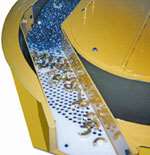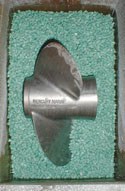Natural Selection
Choosing mass finishing media and compounds
Have you ever walked the beach and picked up a small piece of glass with round, smooth edges? This piece of glass is the result of a natural process of deburring with Mother Nature’s ocean waves as the motor, sand as the media and glass as the part.
Mass finishing performs the same kind of deburring and finishing on manufactured components. Often overlooked, it can be one of the final processes in manufacturing. Careful consideration should be given to this important process to ensure you achieve the proper finish for your parts; otherwise manufacturing costs can escalate sharply and parts may not achieve the required finish.
Featured Content
Because mass finishing is often the final step before parts are packaged and shipped to your customer, attention to detail is important. Of special significance is the choice of media and compound used. This article will look at each, with an emphasis on recent advances in technology that can drastically improve mass finishing productivity by promoting a synergistic relationship between media and compound.
Media Selection
The choice of media is a critical factor in both rotary and vibratory finishing processes. Most media fall into one of two categories: Formed media, and crushed media of irregular size and shape.
Formed media, usually geometric in shape, include spheres of steel, plastic or glass; ceramics; steel pins; and triangular or cylindrical shapes formed from aluminum oxide or silicon carbide plus bonding agents. Crushed and graded media include granite, aluminum oxide, limestone and quartz. In some cases, small pieces of scrap steel from a forming or stamping operation can be used as well.
The function of media in any mass finishing operation is to increase the volume and weight of the mass in order to promote rapid, precise deburring of part edges and smoothing of surface irregularities. It also provides a cushioning, free-flowing action throughout the load that prevents tangling, peening and nicking of the parts.
Two of the main factors in media selection are the size and shape of the parts to be finished. The media must be able to reach all required surfaces without becoming wedged in part features such as holes and recesses. Geometric shapes are widely used where wedging is a potential problem.
Frequently, two sizes of media—one relatively large and one small—are used simultaneously. The large media covers more surface area while the smaller media cushions the action of the large media while getting into restricted part areas, such as between grooves or gear teeth which cannot be reached by the large media. When using media of mixed sizes, a ratio of one part large media to three parts small media usually produces satisfactory results.
Coarse or angular media are useful for removing large burrs and for rounding corners. Media with a rounded shape are recommended when fine finishes are required.
Media-to-parts ratio in a load will generally range from 2:1 to 5:1. Higher ratios should be used when:
- Large or fragile parts are being processed
- Parts may tangle, bend, crimp or nest together
- Soft metals are being finished
- A fine finish is desired
- Hidden or recessed burrs are a problem.
Another option is processing parts with no media—an approach commonly referred to as part-on-part finishing. Many small parts can be finished without media if they are regular in shape, which allows for even contact of all surfaces. The size and shape of the parts, as well as the locations of burrs, are important considerations as well.
When applicable, part-on-part finishing (self-tumbling) is highly economical, because more parts can be loaded into the unit and the time needed to load and maintain media is not a factor. This approach typically requires a longer cycle time and provides little cushioning, so it is not recommended for soft alloys. Part-on-part finishing should not be employed if nesting, tangling, or sticking together of parts is a problem.
Compound Basics
The compounds used in mass finishing are typically mixtures of chemicals blended together to perform certain specific functions.
Recent advances in additive technology have enabled compound suppliers to formulate more “green” products. The term “green” can be overused from a marketing standpoint, as it appears to be a focal point for pretty much every industry. However, reducing the environmental impact of industrial processes is vital to the survival and future success of finishers and manufacturers alike.
All that being said, mass finishing compounds typically consist of some combination of the following:
- Water, which is an excellent dispersant for concentrated additives.
- Detergents, most commonly referred to as surfactants, which are designed to reduce surface tension and aid in the cleaning process.
- Builders, or additives that act as catalysts to improve the function of other additives. Examples include phosphate or silicate compounds.
- Sequestrant, which are chemicals designed to reduce water hardness or to bind or chelate certain metals into a soluble state.
- Wetting agents, which can act as surfactants, detergents and defoamers.
The broadest way to categorize mass finishing compounds is by their physical form—either liquid or powder. Historically, powders were more common. However, recent advances in surfactant technology have allowed liquid products to replace many powders.
Another classification to think about for compounds is workpiece material—either ferrous or nonferrous. Often times, additives that prevent steels, cast irons and other ferrous materials from rusting can stain or darken aluminum parts.
But the most important classification of mass finishing compounds is by their intended function. These include cleaning, burnishing, deburring, descaling and corrosion inhibition.
Cleaning compounds are often the first products used, and they can remove organic soils such as oils, lubricants and greases. This is important, because these soils must be removed before any additional part processing can take place. It is therefore critical that users select the proper cleaner for their application, taking into consideration the workpiece material, duration of rust protection (if required), additional processing after parts are cleaned and the type and severity of the soils being removed.
Burnishing compounds make metals look cleaner, lighter or darker in color, more attractive, and more reflective or brighter in appearance. Burnishing compounds are vital to the success of the finishing operation because they must clean all metal surfaces, provide rust protection to both the parts and the media and provide the proper amount of foam and lubricity. That’s a tall order, but it is completely attainable with sound formulation practices.
A deburring compound provides chemical lubrication and cushioning so that the deburring process can take place. Its primary functions are to keep the media from glazing or loading up, clean and debur the parts and provide rust protection to the parts and media if necessary.
Descaling compounds remove accumulated scale from parts. The scale may be from rust, heat treat operations or other manufacturing processes. Typically, these types of compounds are highly alkaline or highly acidic in nature. Generally ferrous metals require the use of alkaline products and nonferrous materials require acidic chemicals.
Compound Formulation
Controlling foam is especially important in formulation and selection of mass finishing compounds. In certain applications, foam can be provide a beneficial cushioning effect. However, vibratory bowls require a lower-foaming product.
The goal of compound formulators is to prevent users from adding a defoamer to the process. Defoamers can be costly additions that may only mask a deficiency in the mass finishing compound being used. Proper formulation thus requires a balance of additives between those that produce foam and those that suppress foam.
Another important factor is lubricity control. Mass finishing compounds must have lubricity to allow parts and media to “collide” without damaging the parts. Soap can often be referred to as a lubricant; it provides not only lubricity but also detergency
A critical function of any compound formulation is to protect processed parts from rust and oxidation. Traditional methods may have required the application of a solvent-based rust inhibitor, but recent advances have enabled use of water-soluble additives to provide extended rust protection. Our company has formulated compounds used on products that are shipped coast-to-coast with only the water-soluble mass finishing compound as the inhibitor.
Along the same lines, materials that remove rust and oxidation are often found in compounds used for rework or remanufacturing operations where heavy scale, rust and oxidation are being removed. Depending on the metal, these chemicals are usually acidic or caustic.




















